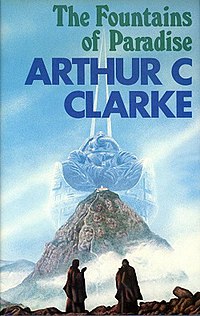This is an old revision of this page, as edited by Arch dude (talk | contribs) at 19:28, 3 March 2007 (nebula succession box). The present address (URL) is a permanent link to this revision, which may differ significantly from the current revision.
Revision as of 19:28, 3 March 2007 by Arch dude (talk | contribs) (nebula succession box)(diff) ← Previous revision | Latest revision (diff) | Newer revision → (diff) Cover of first UK edition (hardcover) Cover of first UK edition (hardcover) | |
| Author | Arthur C. Clarke |
|---|---|
| Language | English |
| Genre | Science fiction novel |
| Publisher | Victor Gollancz (UK) & Harcourt Brace Jovanovich (US) |
| Publication date | 1979 |
| Publication place | United Kingdom |
| Media type | Print (Hardback & Paperback) |
| Pages | 256 pp (first UK edition, hardcover) |
| ISBN | ISBN 0-575-02520-4 (first UK edition, hardcover) Parameter error in {{ISBNT}}: invalid character |
The Fountains of Paradise is a 1979 novel by Arthur C. Clarke. Set in the 22nd century, it describes the construction of a space elevator. This orbital "beanstalk" is a giant structure rising from the ground and linking with a satellite in geostationary or Clarke Orbit at the height of approximately 36,000 kilometers (approx. 22,300 miles). Such a structure would be used to raise payloads to orbit without having to use rockets.
Plot summary
Template:Spoiler In the novel, Clarke uses the life of the ancient king Kalidasa to foreshadow the adventures of engineer Vannevar Morgan in his single-minded determination to realize the space elevator. Subplots in the novel include human colonization of the solar system and the first contact with extraterrestrial intelligence. Clarke also hypothesizes that religion in humans is a consequence of sexual reproduction, although the idea does not play a central role in the novel. The Fountains of Paradise is set in the fictional country of Taprobane, which Clarke has described as "about ninety percent congruent with the island of Ceylon (now Sri Lanka)".
In the novel, Clarke envisions a microscopically thin but strong "hyperfilament" that makes the elevator possible. Although the hyperfilament is constructed from "continuous pseudo-one-dimensional diamond crystal" in the novel, Clarke later expressed his belief that another type of carbon, Buckminsterfullerene, would play the role of hyperfilament in a real space elevator.
The latest developments in carbon nanotube technology brings the orbital elevator closer to possible realization.
The epilogue shows an Earth with several space elevators leading to a giant, "circumterran", space station that encircles Earth at geostationary altitude. The analogy with a wheel is evident: the space station itself is the wheel rim, Earth is the axle, and the six equidistant space elevators the spokes.
Literary significance & criticism
Awards and nominations
- Winner, Nebula Award for Best Novel - 1979
- Winner, Hugo Award for Best Novel - 1980
External links
| Preceded byDreamsnake by Vonda McIntyre |
Nebula Award for Best Novel 1979 |
Succeeded byTimescape by Gregory Benford |